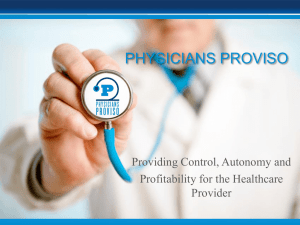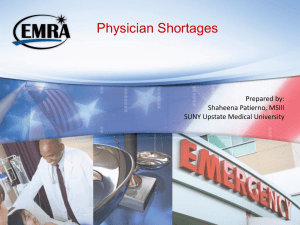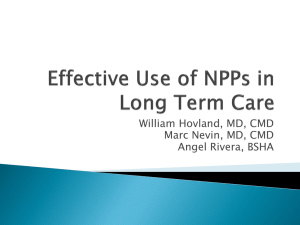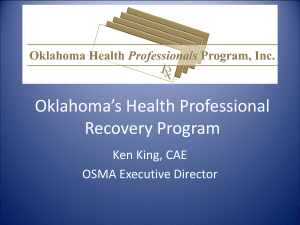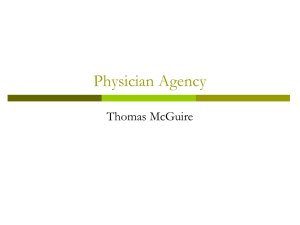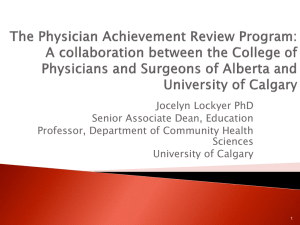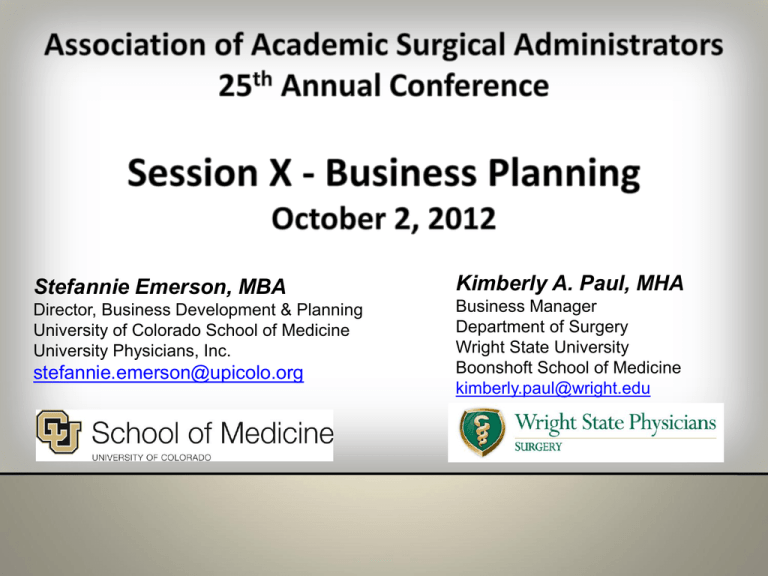
Stefannie Emerson, MBA
Kimberly A. Paul, MHA
Director, Business Development & Planning
University of Colorado School of Medicine
University Physicians, Inc.
Business Manager
Department of Surgery
Wright State University
Boonshoft School of Medicine
kimberly.paul@wright.edu
stefannie.emerson@upicolo.org
Agenda
•
•
•
•
Business Plans and Tools
Case Study 1
Case Study 2
Wrap Up
Key Elements of a Business Plan
•
•
•
•
•
•
•
•
•
•
Executive Summary
Analysis | Data Review
SWOT Analysis
Market Assessment
Feasibility Analysis
Operational Analysis
Financial Analysis
Marketing
Implementation
Evaluation and Exit Strategy
Executive Summary
•
•
•
•
•
•
•
Provide a general description and overview
History and background
Stakeholder and beneficiaries
Scope of services
Highlight the implementation plan
Detail the keys of success
Be sure to
–
–
–
•
Define how the services supports the Enterprise Mission (School, Department, Division and Hospital)
Define how the vision ties into the Mission and is connects the dotes between the current business environment and
related healthcare trends
Use the summary to outline why this service is needed based on the key elements of each area
Tips
–
–
–
–
Write the Executive Summary after the plan is written
Modify the size and level of detail based on the service / recruitment
Have someone read it outside of your program (reduces confusion for leadership)
Keep it simple (don’t use animation and other unnecessary bling)
Analysis
•
•
•
•
•
•
•
•
Clinical Revenue
Payor Mix
Retiring workforce
Grant Funding
Space
Market Share (inpatient)
Profit and Loss Statement
Historical / background Information
SWOT Analysis
Strengths
Superior Clinical Practice –
Outcomes
Weaknesses
Minimal fund raising
Reputation (Marquee
Provider)
Limited access to ORs
Training Programs / Applicants
Lack of hospital support
Research Laboratories
Lack of marketing
Clinical Trials
Opportunities
Scope of services exceeds
community
Clinical revenue
Closing Practice
New capital (DiVinci)
Threats
Limited Block time
Inpatient Beds
Limited Anesthesiology
Disadvantaged payor mix
Market Assessment
• Describe the Market and need for services
• Look forward to determine trends
• Identify demographic information
–
–
–
–
Population
Age, Sex, Ethnicity
Household Income
Largest Employers
• Competitor Profile
– Facility, Number of beds, Physicians, Market Share
– Perform a SWOT on their Practice and/or Facility
• Philanthropic Opportunities
Feasibility
• Check on internal requirements
– Sites of Practice
– Leadership Support
– Physician Champion
• Check on Legal or regulatory challenges
– Stark I, II, III; Antikickback statute
• Other Barriers
– Technology
– IS
Current Sample Project Plan
Operational Assessment
• Create a high level project management plan that describes
each step
• Look at Staffing
– Physicians / Ancillary staff / support staff
– Be sure to review the need for other talent resources like anesthesiology,
radiology, and pathology
• Look at Facility Requirements
– Rooms
– Operating Rooms
– Capital Equipment
Financial Analysis
• Hospital
– DRG | MSDRG
• Professional
– CPTs
• If established provider seek historical reports; 3 years
• If new graduate
– Look at like physician within the Department/Division
– Look at FPSC Clinical Footprints
• Enterprise
– Payor Mix
Sample Financial Plan
Marketing
• Outline how the program can and should be
marketed as well as include the anticipated
cost
• Look at internal and external audiences
– Internal
• AMC faculty and hospital staff
– External
• Direct to Patients
• Referring Physicians and Providers
Implementation
• Identify key stakeholders
• Socialize the draft plan prior to submittal
• Use the agreed upon project management
plan as the map to success
Evaluation and Exit Strategy
• Describe how you will define success
– ROI
• Hospital frequently uses contribution margin
• Departments/Division use contribution to department
and ability to cover direct and indirect costs as well as
the ability to contribute to incentives
• Describe how you will titrate or terminate the
service if things are not going well.
Tool Box
• MGMA (especially Special Interest Groups)
• Current Tools at CU
– Truven Health (AKA - Thomson Reuters )
– Peregrine
– Colorado Hospital Association
• UCH and TCH
– Google Analytics
• Tools in Development
– Health Connect
Thoughts and Questions
•
•
•
•
Always perform a sensitivity analysis
Educate key stakeholders frequently
Ask for help – Tap your resources
Scale and use these tactics for small to large
opportunities – internal and external
• Questions?
Case #1
Background
• Faculty within the Department of Surgery and Medicine
were approached by a for-profit company to invest in a
new venture within five miles of the Academic Medical
Center
• Each department had access to limited one time funds
to invest in such a venture
• The service was not duplicative of a service rendered at
either hospital, therefore it would allowable to invest
• The proforma looked promising to the faculty and cash
flowed year one
• Faculty were anxious and ready to invest
• Business Development and Planning was engaged to
review the business plan and provide a
recommendation
The Deal - Financial
• $6.5 m Investment (CU $2.6m)
• Facility would be built to capacity; operationally could add
hours over time to increase volumes
• Cash Flows In Year 1
• Revenue
– Escalated at 5% per annum
– Payor mix based on Denver experience to date
• Expenses
– Escalated at 5% per annum
– Management fee built into proforma
– Development fee was built into construction budget
• Capital Contribution was recaptured at year 8
The Deal – Operating Agreement
• Governance
– Decision Making
• Non Competes | Exclusivity
• Ability for Private Practice Physician
Ownership
• Medical Directorship
Why
• Company
– when physicians invest - venture has a higher success rate
– Ability to share investment costs and limit risk
• Company has positive reputation; long time player in
the market
• Departments believed that they could steer tertiary
and quaternary business
• Departments looking for access to ancillary revenue
• Departments could capture research subjects
• The proposed location was highly desirable
Why Not
• Risk of payment changes in short and long-term
– Including bundling
• Nursing shortages
• Competitor entering market and building site in
same area
• Question return on investment
• Is growth rate attainable
• What is the Opportunity Cost
Review Process
• BDP
– Reviewed data provided by the Company and
requested additional information including scenarios
• Looking for exposure to cash calls
– Researched the company
– Talked to current medical director of a current facility
(faculty held position)
– Contacted three other institutions who invested in
similar ventures
– Generated a Report and Recommendation to
Departments
Report
•
•
•
•
•
•
•
•
•
•
•
•
•
•
•
•
•
Overview of Company
Summary of Department/Division Goals
Type of Venture
Clinical Services
Competition and Competitive Advantage
Feasibility
Health Reform / Potential Payment Changes
Impact to other Departments
Short and Long term Impact
Contribution to System
Legal Considerations
Funds Required
Assumption Review
Financial Review
Other Considerations
Recommendations
Appendix
– Summary of discussion with other AMC(s)
Recommendation | Conclusion
• It was recommended not to invest; Each
Department had the necessary information to
determine if they wanted to proceed
• Departments were urged to look at other ways
to align
– Example, Medical Directorships
• Several of the faculty were not supportive of
the recommendation
Tips and Tricks
• Don’t hesitate to ask for additional
information
• Don’t hesitate to ask for new financials
• Challenge the assumptions rigorously
• Look at future for reimbursement
• Review assumptions with the company,
faculty and outside colleagues who have
similar ventures
Case #2
Business Case: Physician Salary Support
Wright State University Boonshoft School of Medicine
– 1973: approved by Ohio Legislature
– 1976: first class accepted
– 2005: school renamed Boonshoft School of Medicine
honoring a $28.5 million donation by local philanthropist
Oscar Boonshoft.
Wright State Physicians
– 1977: founded as University Medical Services Association
– 1993: incorporated as a Not for Profit entity
Business Case: Physician Salary Support
Background:
– Instead of operating a university-based hospital for clinical
training, WSU is affiliated with 7 major teaching hospitals
in the Dayton area
– Formal affiliation agreements with 25 other healthcare
institutions in the Miami Valley
– Residency training in 13 medical subspecialties and
fellowship training in 10 subspecialties for almost 400
resident physicians and fellows
– 400 full-time faculty
– Over 1,240 voluntary faculty in private practice and other
community healthcare professionals
Business Case: Physician Salary Support
The Ask:
– Fixed Price contracts from Dayton area hospital systems
– “Teaching Formula”
• Based on Resident : Faculty ratio
• Does not take into account hospital service line growth and
development needs
– Strengths
• Know the “pot” of money we’re dealing with
• Data-driven
– Weaknesses
• Can only pay new faculty base salary if someone else separates
• Again, does not take into account hospital service line growth
Business Case: Physician Salary Support
Secure base salary in the form of a medical directorship
1. Provide justification for such position
2. Categorize and allocate responsibilities needed with
narrative and spreadsheet (templates)
a)
b)
c)
d)
Administrative
Clinical
Outreach
Education
3. Contract executed between hospital system funding position
and Wright State Physicians, Inc.
a) Complete and submit time sheets and invoices monthly
b) Incorporated into their monthly distribution
Dr. Jane Smith
Surgical Director of ABC, XYZ Hospital
Stipend proposal
$ 162,630.00 stipend
1,084.20
Administrative
Clinical
Outreach
Education
25
15
35
25
90.35
hours
hours per month
Administrative
Clinical
Outreach
Education
Business Case: Physician Salary Support
Tips and Tricks:
• Ensure presence at the table – offering service
hospital needs
• Facilitate physician input so crucial to service line
success
• Open communication, solid relationship with
hospital administrative director
• Be the advocate!


